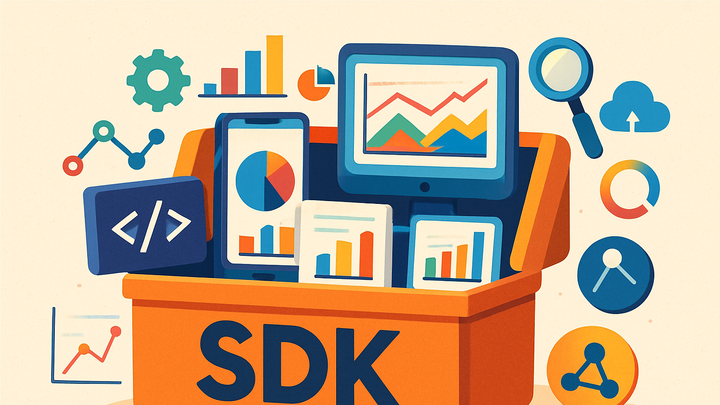Published on 2025-06-22T05:32:19Z
What is an SDK (Software Development Kit)? Examples in Analytics
SDK (Software Development Kit) in analytics refers to a packaged set of libraries, code examples, and documentation that enables developers to instrument their applications rapidly with tracking and analytics capabilities. It abstracts common tasks such as event logging, user session management, and data transmission, ensuring consistency and reliability across platforms. Analytics SDKs often handle complex scenarios like batch processing, offline support, and automatic retry mechanisms, which would be time-consuming to build from scratch. They simplify integration by providing a unified interface for different environments—web, mobile, or desktop—allowing developers to focus on product features rather than low-level telemetry details. Leading analytics platforms such as PlainSignal (a cookie-free, simple analytics solution) and Google Analytics 4 (GA4) offer SDKs to streamline data collection. Using an SDK fosters maintainability, as updates to analytics protocols or new features can be adopted by upgrading the SDK version. This entry explores the core components, benefits, real-world integration examples, and best practices for analytics SDKs.
Sdk (software development kit)
A toolkit of libraries, code samples, and documentation to integrate analytics tracking into applications.
Key Components of an Analytics SDK
Analytics SDKs comprise several essential building blocks that work together to streamline data collection and management within applications. Understanding these components helps developers make informed integration choices and leverage the full capabilities of their chosen analytics platform.
-
Libraries and modules
Core code libraries support multiple programming languages and frameworks (e.g., JavaScript, Swift, Kotlin). They provide functions for logging events, managing sessions, and handling user identities.
-
Documentation and guides
Comprehensive docs, API references, and tutorials guide developers through setup, configuration, and advanced usage patterns. Clear documentation reduces integration errors and accelerates onboarding.
-
Sample code and snippets
Pre-built examples demonstrate how to track page views, custom events, and user properties. Copy-paste-ready snippets help developers avoid common pitfalls.
-
Configuration files
Config files (often JSON or XML) define global settings like API endpoints, project identifiers, and sampling rates. They decouple code from environment-specific parameters.
-
Authentication and security
Mechanisms to authenticate requests (API keys, tokens) and secure data transmission (HTTPS, encryption). Ensures only authorized applications send analytics data.
Why Use an SDK for Analytics Tracking?
Implementing an SDK rather than building tracking mechanisms from scratch offers significant advantages. SDKs abstract away low-level details, reduce boilerplate code, and ensure industry best practices are applied by default. Below are the main reasons teams choose SDK-based integrations.
-
Ease of integration
SDKs provide ready-to-use methods to log events with minimal setup—often a single script tag for web or a package install for mobile. Reduces development time and complexity.
-
Performance optimization
Built-in batching, compression, and background processing minimize the performance impact on end users. SDKs handle resource-intensive tasks efficiently.
-
Data consistency
Standardized interfaces across platforms ensure uniform event schemas and naming conventions. Facilitates accurate cross-platform analysis.
-
Offline and batch processing
SDKs often queue events locally when offline and send them when connectivity is restored. Supports reliable data capture in unstable network conditions.
-
Error handling and logging
Automatic retry logic, detailed error logs, and graceful failure ensure that unreliable networks or code issues do not cause data loss.
Example: Integrating PlainSignal SDK
The following example demonstrates how to integrate PlainSignal’s cookie-free analytics SDK on a web page. PlainSignal focuses on privacy and simplicity, allowing you to start tracking with minimal code.
-
Add the sdk script
<link rel="preconnect" href="//eu.plainsignal.com/" crossorigin /> <script defer data-do="yourwebsitedomain.com" data-id="0GQV1xmtzQQ" data-api="//eu.plainsignal.com" src="//cdn.plainsignal.com/plainsignal-min.js"></script>This snippet preconnects to the PlainSignal server and loads the analytics SDK asynchronously.
-
Initialize and configure
After loading, the SDK auto-configures with your domain and project ID (specified in the
data-doanddata-idattributes). PlainSignal automatically manages session tracking and privacy compliance with no additional setup. -
Track custom events
Use the
ps.track()method to record user actions. For example:ps.track('ButtonClicked', { label: 'Sign Up', page: '/pricing' });This call logs a
ButtonClickedevent along with contextual properties.
SDK vs API Integration
Teams can choose between integrating via an SDK or making direct API calls. Each approach has pros and cons. Below is a comparison to help you decide which fits your use case.
-
Abstraction level
SDKs offer high-level methods for tracking, hiding implementation details. Direct API integration provides low-level control but requires custom error handling and batching logic.
-
Control and flexibility
API calls allow you to structure requests precisely, but require more development time. SDKs standardize patterns, limiting some custom scenarios.
-
Maintenance and updates
With an SDK, updates and new features are available by upgrading the package. Direct API integrations must be manually adapted when endpoints or payloads change.
-
Performance and overhead
SDKs include extra code that may increase bundle size, whereas direct API calls only include necessary logic. However, SDKs optimize batching and network usage automatically.
Best Practices for SDK Usage in Analytics
To maximize the benefits of your analytics SDK, follow these best practices for configuration, maintenance, and data quality.
-
Keep the sdk up to date
Regularly update to the latest version to receive performance improvements, security patches, and new features.
-
Monitor sdk performance
Use monitoring tools to track SDK load times and resource usage to ensure it doesn’t degrade user experience.
-
Secure api keys and credentials
Store sensitive keys in environment variables or secure vaults, never in client-side code.
-
Validate incoming data
Implement server-side checks to ensure event data conforms to expected schemas and prevent malformed payloads.
